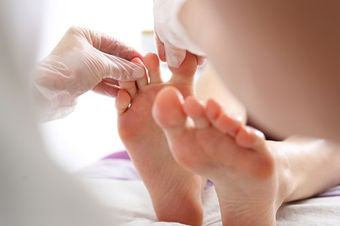PODIATRY CARE & SERVICES
Port Washington Podiatry Services

At Port Washington Podiatry, we believe that an informed patient will be better able to care for his or her podiatric condition or injury. We’re committed to making sure our patients completely understand what’s going on in their feet
and ankles, and what the best ways to treat it will be. When you visit us, we’ll take the time to fully understand your issues and come up with a personalize treatment plan that works for you. Contact Port Washington Podiatry today to speak with a specialist!
Please take time to read more about the conditions we treat on the podiatry conditions page of our website.
Achilles Tendon
Treatment for Achilles tendon injuries depend upon a number of variables, including the degree of injury and how long the injury has been present. Some treatment options include immobilization, ice, medication, orthotics, night splints and physical therapy.
Ankle Sprain
Treatment for an ankle sprain should begin the moment the injury occurs. Some options include rest, ice, elevation, compression, physical therapy and medication.
Arthritic Foot And Ankle Care
Treatment for arthritis of the foot and ankle can include medications, orthotic devices, bracing, immobilization, steroid injections and physical therapy.
Athlete’s Foot
The best way to prevent athlete’s foot is to avoid walking barefoot and practice good foot hygiene. You should make sure to wash your feet daily with soap and water. Some treatments include anti-fungal powders, sprays and creams.
Bunions
In many cases, surgery is not required to treat bunions. Some non-surgical treatment options include wearing the right kind of shoes, padding, avoiding activities that aggravate the bunion, medication, ice, injection therapy and orthotic devices.
Calluses
A callus is thickened skin that can accumulate on the foot by pressure and repeated rubbing, like from a shoe or sock. There are many different types of treatment depending on the level of pain you are experiencing and the severity of the calluses.
Corns
Corns should be treated based on the recommendation of your podiatrist, not through in-home treatment. There are many different options depending on the cause and severity of your corns.
Diabetic Foot
When you’re suffering with diabetes, it is vital to maintain proper foot care, as blisters and sores could lead to an infection that puts you at risk for an amputation. The most important piece of advice is to make sure you inspect your feet daily and call your doctor immediately if you notice something.
Flatfoot
When you have flatfoot, or posterior tibial tendon dysfunction (PTTD), it is recommended to begin treatment as early as possible. Some treatment options can include orthotic devices, bracing, immobilization, physical therapy, medications, and shoe modifications. Surgery is also an option for more severe cases.
Fungus Toenails
Fungus in the toenails can cause a lot of issues, including deformity and thickening of the nail. When dealing with a fungus, it is important to speak with your podiatrist about recommended treatment options.
Hammertoes
Hammertoe is a progressive condition that won’t just go away on its own. Some treatment options include padding corns and calluses, changing to proper shoes, orthotic devices, injection therapy, medications, splinting and strapping. Surgery is also an option for more severe cases.
Ingrown Toenails
There are many reason you can get an ingrown toenail, including heredity, trauma, improper trimming and more. Treatment for ingrown toenails can usually be performed at home for less severe cases. If you suspect the area may be infected or have another pre-existing condition, it is best to consult with your podiatrist before treatment.
Neuroma
Before recommending a treatment plan for your neuroma, there are many different considerations your doctor will take into account. Some non-surgical treatment options include padding, icing, orthotics, activity modifications, changing to proper shoes, medications, and injection therapy. Surgery is also an option for more severe cases.
Plantar Fasciitis
Plantar fasciitis has a wide range of severity, from minor heel discomfort to full-fledged immobility. Some treatment options include stretching, wearing supportive shoes, ice, medications, padding, orthotic devices, injection therapy, walking casts, night splints and more. Surgery is also an option when other treatments fail.
Warts
While some warts may eventually clear up on their own, many would prefer faster relief. Some faster treatment options include topical or oral treatments, laser therapy, cryotherapy, acid treatments or surgery.
Ulcers
Ulcers are generally treated by removing the unhealthy tissue and performing local wound care. Addition options include wearing special shoes or padding, medication or surgery.
Puncture Wounds
When you have a puncture wound on your foot or ankle, it is important to make sure the area has been cleaned. You should also see a podiatrist to make sure there are no foreign bodies or infections present.
BROWSE OUR WEBSITE
CONTACT INFORMATION
Address:
1317 W. Grand Ave. Port Washington, WI 53074
Phone: 262-284-8800
Email: jdjbong1@sbcglobal.net
OUR LOCATION
- Mon, Wed
- -
- Tue, Thu
- Appointment Only
- Friday
- -
- Sat - Sun
- Closed
Content, including images, displayed on this website is protected by copyright laws. Downloading, republication, retransmission or reproduction of content on this website is strictly prohibited. Terms of Use
| Privacy Policy
